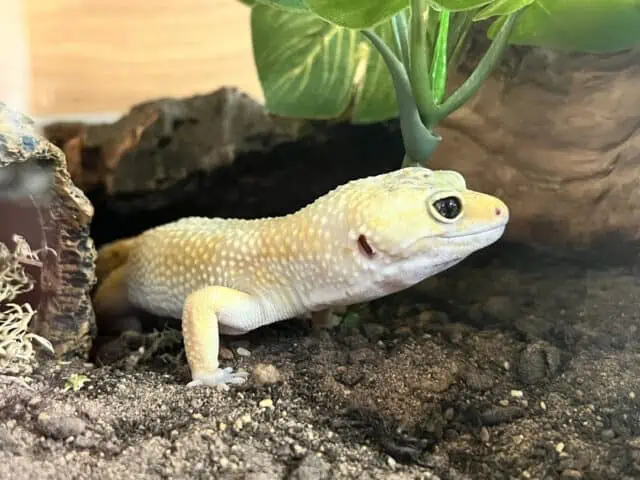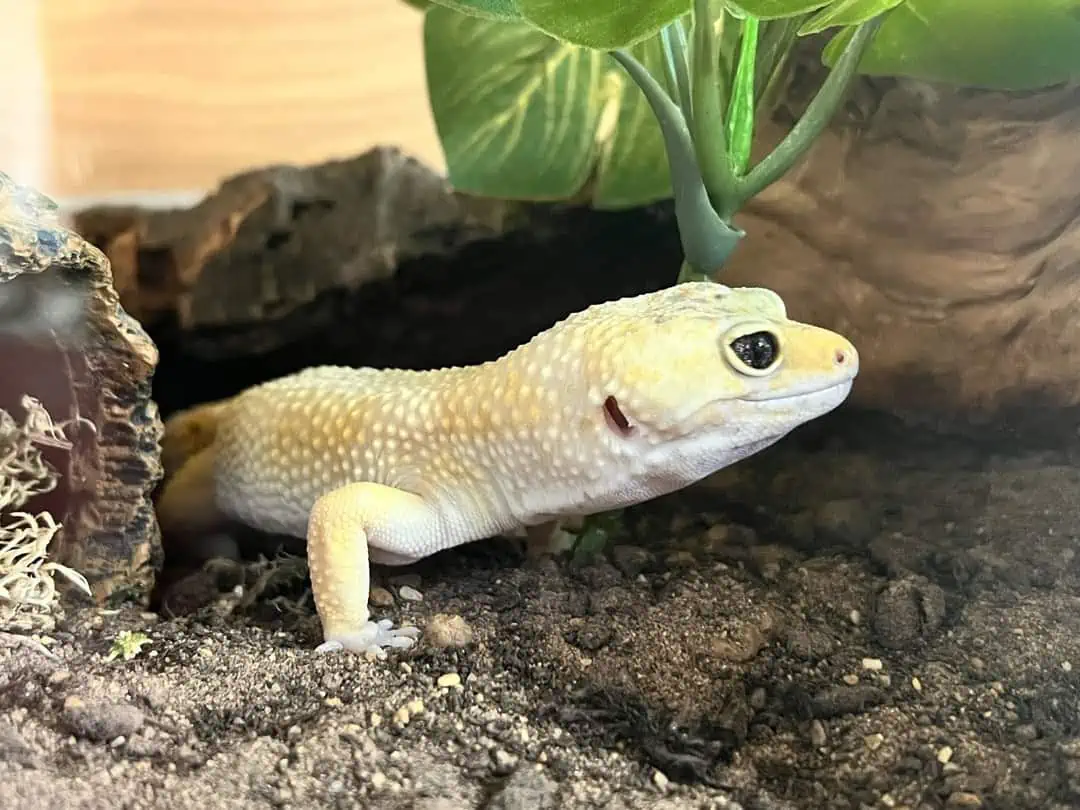The Super Hypo Leopard Gecko is a captivating and unique reptile, famed for its distinctive appearance and adaptive traits. This intriguing creature stands out due to its lack of spots, a characteristic that sets it apart from its more commonly spotted relatives.
With a sleek, clean appearance, it is a favorite among reptile enthusiasts and breeders alike. The Super Hypo morph is celebrated for its vibrant and diverse patterns, displaying a plethora of colors that make each individual uniquely fascinating.
- Super Hypo Leopard Geckos are identified by their lack of spots and distinct appearance compared to other leopard gecko morphs.
- Breeding Super Hypos involves understanding genetic inheritance and dealing with the unpredictability of hypo trait expression.
- Proper care, including suitable housing with appropriate temperature, humidity, and substrate, is vital for the health and longevity of the gecko.
- Understanding and respecting the solitary and territorial nature of Super Hypo Leopard Geckos is essential for their well-being.
- Regular, gentle handling using the scoop and support method ensures stress-free interaction with your gecko.
Super Hypo Leopard Gecko: Quick Facts
| Morph Name | Super Hypo Leopard Gecko |
|---|---|
| Species | Eublepharis macularius |
| Lifespan | 15-20 years |
| Size as an adult | 7-10 inches |
| Diet is made of | Insects, such as crickets, mealworms, and roaches |
| Required Tank Size | 10-20 gallons for one gecko, larger for multiple |
| Temperature range | 88-92°F (day), 70-75°F (night) |
| Humidity range | 30%-40%, with higher humidity in the moist hide |
What is a Super Hypo Leopard Gecko?

A Super Hypo Leopard Gecko is a morph of the leopard gecko, one of many available (including Sunglow, etc). It’s known for having no spots on its body. This trait makes it different from the Hypo Leopard Gecko, which has some spots. Super Hypos are interesting because they can have many looks. Breeders use them to get babies with a variety of appearances. They are a favorite for those who love unique and diverse reptile pets.
Origins and History
To fully appreciate the allure of the Super Hypo Leopard Gecko, it’s essential to explore its roots and the journey of its development.
The Super Hypo Leopard Gecko didn’t just appear out of nowhere. It’s the result of careful trait development. Over time, breeders noticed some leopard geckos had fewer spots. These were called “hypo”. As breeding continued, some geckos had no spots at all. These became known as the “super hypo leopard gecko”. This no-spot trait is what makes them distinct.
Breeders work hard to get a certain look in their baby geckos. They want consistent appearances. But the super hypo trait can vary. Some babies might show slight differences, even with the same parents. This variability is what makes breeding both challenging and exciting. Yet, through dedication and knowledge, breeders manage to produce stunning and predictable results.
Breeding Process for Super Hypos
Breeding Super Hypo Leopard Geckos is a meticulous process. These unique geckos are line bred. It means breeders pick geckos with the best traits and breed them together. The goal is to produce offspring with those same great traits. The breeding season is crucial. Leopard geckos usually lay eggs once the weather gets warm.
Leopard geckos have their quirks when it comes to egg-laying. They can lay multiple clutches of eggs in one breeding season. However, breeding for the hypo trait can be unpredictable. Even when two hypos are bred together, there’s no guarantee all the babies will be hypos.
The odds and probabilities play a huge role in breeding Super Hypo Leopard Geckos. Breeders often mix hypos and test breed them to explore the possibilities of different trait combinations. They aim to understand the inheritance patterns better and to produce geckos with the most desirable traits. This unpredictability in results is part of what makes the breeding process so intricate and fascinating.
Physical Characteristics of Super Hypo Leopard Geckos
When it comes to physical characteristics, the Super Hypo Leopard Gecko is a showcase of uniqueness and diversity. Beyond their defining lack of body spots, these geckos exhibit a range of sizes, colors, patterns, and more, each adding a layer to their fascinating persona.
Size, Weight, and Lifespan
An adult Super Hypo Leopard Gecko typically measures about 8 to 10 inches in length.
When it comes to weight, a healthy Super Hypo should weigh between 45 to 65 grams. Monitoring weight is important, as it’s a key indicator of their overall health.
Super Hypo Leopard Geckos have a lifespan of around 15 to 20 years, given proper care.
Body Structure and Coloration
The Super Hypo Leopard Gecko’s body structure is robust and well-formed, featuring a broad head, large eyes, and a thick tail, which stores fat. Coloration in Super Hypos is particularly interesting, with the absence of spots highlighting their unique physical characteristics and allowing other colors and patterns to take center stage.
Variations abound in this morph, with colors ranging from bright yellows to soft creams, and patterns manifesting in intriguing arrays and distributions. Each Super Hypo is a canvas painted with its unique combination of hues and designs, making them a favorite among enthusiasts.
Delving into the world of albino morphs, we encounter Tremper, Bell, and Rainwater – each distinctive in its genetic makeup and appearance. These albinos display variations in eye color and body hue, adding another layer to the rich tapestry of Leopard Gecko morphs.
Additionally, there’s the High Yellow morph, notable for its vibrant, intense yellow coloration interspersed with minimal patterning, another exciting variant in the diverse world of Leopard Geckos.
Patterns and Markings
Super Hypo Leopard Geckos, renowned for their spotless appearance, exhibit an array of patterns and markings that make them unique. Among these patterns, the Patternless and Murphy Patternless morphs stand out. While both lack the typical spots and bands found in other geckos, the Murphy Patternless differs slightly with a muted coloration that intensifies as they age, eventually leaving them almost entirely without pattern.
Diving deeper into the genetics, Leopard geckos possess two copies of each gene in their DNA. These genes can undergo mutations, known as alleles, which are frequently tied to specific morphs. This means that the appearance of a Leopard Gecko is a result of the combination of alleles it inherits from its parents.
Understanding genetic inheritance in Leopard Geckos is paramount for breeders. The four most common patterns of inheritance for mutations include:
- Dominant: Where only one mutated gene is needed for the morph to manifest.
- Recessive: Where two copies of the mutated gene are required for the morph to show.
- Co-dominant: Here, having one or two copies of the mutated gene results in different appearances.
- Polygenic: A trait influenced by multiple genes, leading to a spectrum of appearances.
Tail Types and Variations
Super Hypo Leopard Geckos exhibit several interesting tail types and variations, contributing significantly to their aesthetic appeal. One noteworthy variant is the Carrot Tail morph, distinguished by its vivid orange tail, which can sometimes extend up to the body, creating a striking contrast to its primarily pale body coloration. This vibrant coloration is a highly sought-after trait and is indicative of the morph’s name, resembling the color of a carrot.
Additionally, variations can also include the Carrot Head, where the orange coloration is predominantly on the head of the gecko, adding an extra layer of uniqueness to its appearance.
Temperament of Super Hypo Leopard Geckos
When exploring the temperament of Super Hypo Leopard Geckos, it’s fascinating to observe their behavior and social inclinations, revealing a creature of unique characteristics and engaging quirks.
Social Tendencies
Super Hypo Leopard Geckos exhibit intriguing social tendencies, preferring a solitary and reserved lifestyle. These reptiles value their own space, interacting minimally with other geckos to avoid conflict, and often showcasing territorial behavior. Providing multiple hiding spaces within their habitat is crucial, allowing them to retreat and feel secure in their surroundings, mitigating stress and potential confrontations.
Handling Tips for Owners
Handling Super Hypo Leopard Geckos requires attentiveness and a delicate touch, as improper handling can stress or harm them. Adopt gentle and slow movements when interacting with these geckos, always considering their comfort and safety. The scoop and support method is recommended when picking them up; gently scoop them from below and support their body, ensuring they are secure and reducing the risk of falls. Owners should be mindful of the duration and frequency of handling sessions, moderating interaction to foster acclimation and maintain the gecko’s well-being.
Care Requirements for Super Hypo Leopard Geckos
Caring for Super Hypo Leopard Geckos involves attending to their unique needs and environmental preferences to ensure their well-being and longevity. Familiarizing oneself with the essential aspects of their husbandry, such as proper diet, habitat conditions, and health precautions, is crucial.
Housing Needs
Super Hypo Leopard Geckos have specialized housing needs that must be meticulously met to ensure their health and comfort. An appropriate enclosure is paramount; a terrarium of adequate size and type is needed, with experts recommending a 20-gallon tank for one adult.
The gecko’s enclosure should have precise temperature and humidity levels, with a gradient to allow the reptile to self-regulate its body temperature, typically a warm side at around 88-90°F (31-32°C) and a cool side at about 75°F (24°C).
Substrate options are diverse; however, choosing one that prevents impaction, such as reptile carpet or newspaper, is critical. For these nocturnal creatures, providing ample hiding spots is essential for their sense of security and overall well-being.
Though they are not dependent on light for metabolic processes, like some reptiles, maintaining a natural light cycle can benefit their circadian rhythm.





